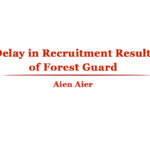In recent discussions on the challenges facing Nagaland’s development, there’s a tendency to attribute the blame to Article 371A or its alleged misuse. This situation calls for a more nuanced examination that transcends singular perspectives.
Assertions linking the hindrance to the perceived misuse of Article 371A warrant a closer look, as they oversimplify intricate issues and perpetuate an incomplete narrative. Associating Nagaland’s development hurdles with Article 371A, designed to protect the unique identity, customs, and land of the Naga people, overlooks the broader historical context.
Article 371A has been crucial in safeguarding against potential exploitation of the Naga identity and resources amid haphazard development projects that often favor elite interests and neglect broader community needs.
Generalized claims that individuals obstruct infrastructure projects, causing suffering for the entire state, oversimplify complex challenges, and dismiss systemic issues like corruption, mismanagement, and skewed priorities in the implementation of development initiatives.
Suggesting that individuals are misusing Article 371A ignores the struggles of communities attempting to preserve their cultural and traditional heritage amidst external pressures. This is victim-blaming which not only overlooks systemic challenges but unfairly places responsibility on individuals, hindering the development of genuine solutions.
To address Nagaland’s development challenges, a holistic approach is imperative. Engaging in constructive dialogues that involve the community and address their concerns is essential. Efforts should focus on finding a balance that respects cultural and traditional rights while ensuring progress and development for the entire state.
Article 371A grants overarching powers to the Nagaland Legislative Assembly over its provisions. Thus, blaming 371A for government ineptitude or impotence is an ostensible excuse. If blame is to be assigned, it falls on the government.



